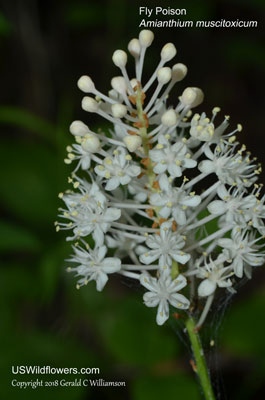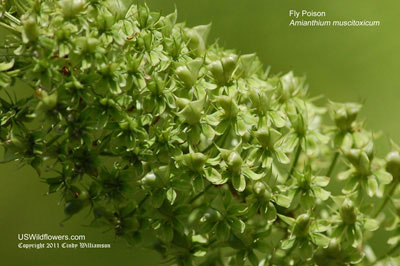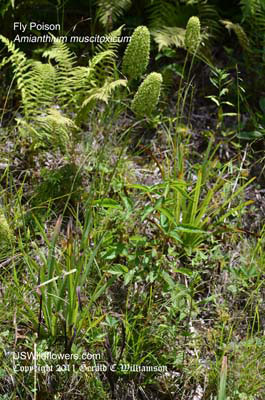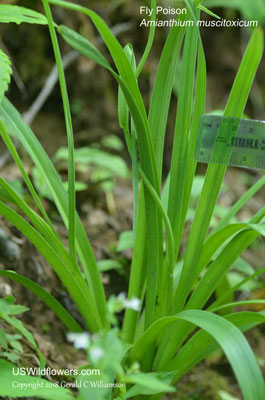Fly Poison, Stagger Grass - Amianthium muscitoxicum
|
Amianthium muscitoxicum - Fly Poison, Stagger Grass. Amianthium muscitoxicum is monotypic - this is the only species in the genus, although it is closely related to Death Camas (Toxicoscordion, Stenanthium, Zigadenus, Anticlea), from which it can be distinguished by the brown bracts within the inflorescence, and by having a denser cluster of basal leaves. These genera have been recently moved out of Liliaceae and into the Melanthiaceae - False-Hellebore - family
The species epithet translates to Fly Poison, indicative of the poisonous nature of the plant. All parts are poisonous. The bulb, which is especially poisonous, is a natural insecticide, but in spite of that, some butterflies eat the nectar of the plant without adverse effect. The alternate common name of Stagger Grass is because cattle which eat the plant will stagger, and then perhaps die, from the effects of the poison.
Amianthium muscaetoxicum is an alternate spelling of the scientific name which is not accepted by most authorities. Zigadenus muscitoxicus is a synonym, indicating the close relationship to the genus by which most Death Camas have been classified until recently.
It is Threatened in Kentucky.
Found in:
AL, AR, DE, FL, GA, KY, LA, MD, MO, MS, NC, NJ, NY, OK, PA, SC, TN, VA, WV
Leave comments on Amianthium muscitoxicum at this link. | 
Distribution of Amianthium muscitoxicum in the United States and Canada:

Blue=Native; Grey=Introduced
Map from USDA Plants Database:
USDA, NRCS. 2017. The PLANTS Database (http://plants.usda.gov, 08 May 2025). National Plant Data Team, Greensboro, NC 27401-4901 USA.
Search Our Database: Enter any portion of the Scientific, Common Name, or both.
Do a general Google search of the entire site:
#ad
 Follow USWildflowers on Twitter
#ad
| | Site: GSMNP, Heintooga Ridge Road (Blue Ridge Parkway spur), Swain County, NC Date: 2011-August-01 | Photographer: Cindy Williamson
Nikon D40
| | The blossoms are white until they are pollenated, when they will turn the pale green shown in these photos, generally about two weeks after full bloom. Note the brown bracts within the raceme at the base of the flower stems; this is another indicator that this is Fly Poison rather than one of the Death Camas species. | | 
| | Site: Qualla Boundary, NC Date: 2018-June-14 | Photographer: Gerald C Williamson
Nikon D7000 | | The dense inflorescence of white flowers is usually about 2" to 3" long, but will elongate as the plant ages, turning green after pollenation. | | Click on the photo for a larger image

| | Site: GSMNP - Heintooga Ridge Road (Blue Ridge Parkway spur), Swain County, NC Date: 2011-August-01 | Photographer: Cindy Williamson
Nikon D40 | | Fly poison has 6 tepals which are initially white, but turn green when pollenated. The blossom also has 6 stamens above the tepals, and 3 tiny stigmas at the end of the styles which can be seen in this photo above the swollen ovaries. | | Click on the photo for a larger image

| | Site: GSMNP - Heintooga Ridge Road (Blue Ridge Parkway spur), Swain County, NC Date: 2011-August-01 | Photographer: Gerald C Williamson
Nikon D7000 | | The raceme (cluster of blossoms each on an individual stalk from the central stem) terminates a mostly leafless stem, arising from a cluster of narrow, grass-like leaves. | | Click on the photo for a larger image

| | Site: Qualla Boundary, NC Date: 2018-June-14 | Photographer: Gerald C Williamson
Nikon D7000 | | The density of the tuft of basal leaves is one of the differentiators between Fly Poison and the various Death Camas species. The leaves are up to 16" long and usually less than an inch wide. | | Click on the photo for a larger image

|
References used for identification and information:
|
|
| |
| #ad
|
|







